Indian city old (ancient) names and new (today’s / modern) names
Namaste friends, how are you doing today? Welcome to #BhagavanBhakthi website / blog.
Bhagavan Lord Sri Krishna blessings to you and your family!
In this website / blog, you will always learn about #Hinduism #Sanskrit language.
Also subscribe to my YouTube channel from this link #BhagavanBhakthi to view videos about #Hinduism #Sanskrit language.
Just before moving towards to know about “Indian city old (ancient) names and new (today’s / modern) names“, let us know few basic information.
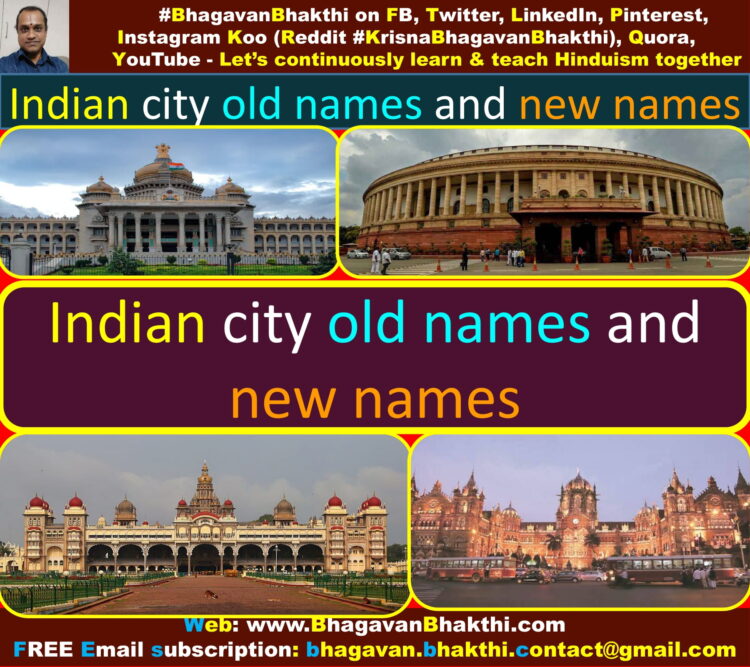
India (Bharat) (Bharata) is the oldest nation on earth and the oldest civilization.
Indian city names have always been changed time after time and thus you can find a huge difference in the old city names and new city names.
Now, let us know a list of “Indian city old names and new names”.
In the below list, read the first name as the present city name and later you will find the new city names of the India.
The list of the “Indian city old (ancient) names and new (today’s / modern) names” is as given below:
Anegundi (Anegondi) : This is town in Karnataka and earlier it was called as ‘Kishkinda‘.
Yes, you are right, this is the place of Lord Hanuman.
Anegundi (Anegondi), was also called as ‘Gaja-Gahvara‘, known in Kannada as anegondi.
This is a small island near Hampi across the Tungabhadra river.
In the 14th century A.D., the place Anegundi (elephant enclosure) got its name from the Vijayanagar army.
Vijayanagar army had its elephant contingent in the hilly stations of the fortified capital Anegundi located on the banks of the Tungabhadra.
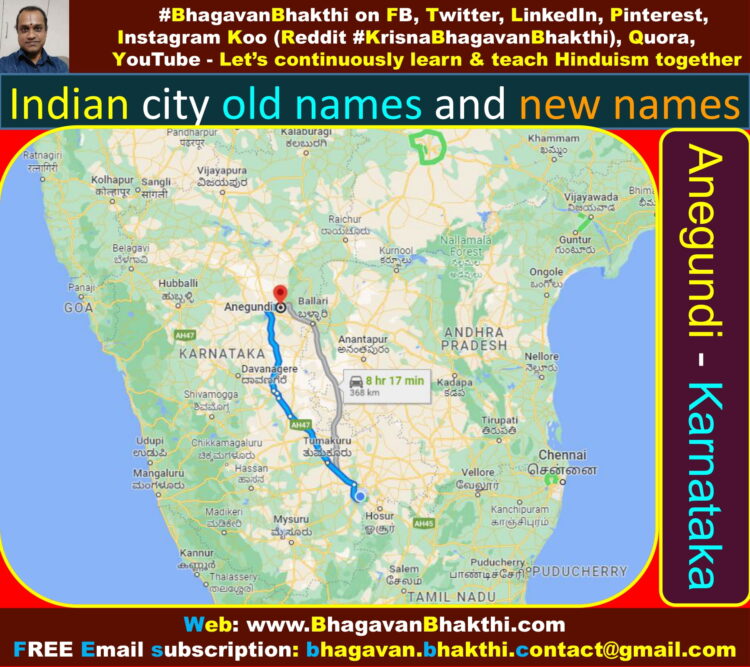
Patna : The original name of Patna was called as ‘Pataliputra‘ or ‘Patalipattana‘ or ‘Patalipattan‘.
Patna’s history goes back to 600 B.C. century.
Earlier, Patna was also known as Kusumpur, Patlipura, Pataligram, Kusumpur, etc.
Legend narrates the origin of city Patna to a King by name Putraka, who created Patna by magic for his queen Patali.
Patali literally means “trumpet flower”, which gives it its ancient name ‘Pataligrama‘.
It is said that in honour of the queen’s first-born, the city was named ‘Pataliputra‘.
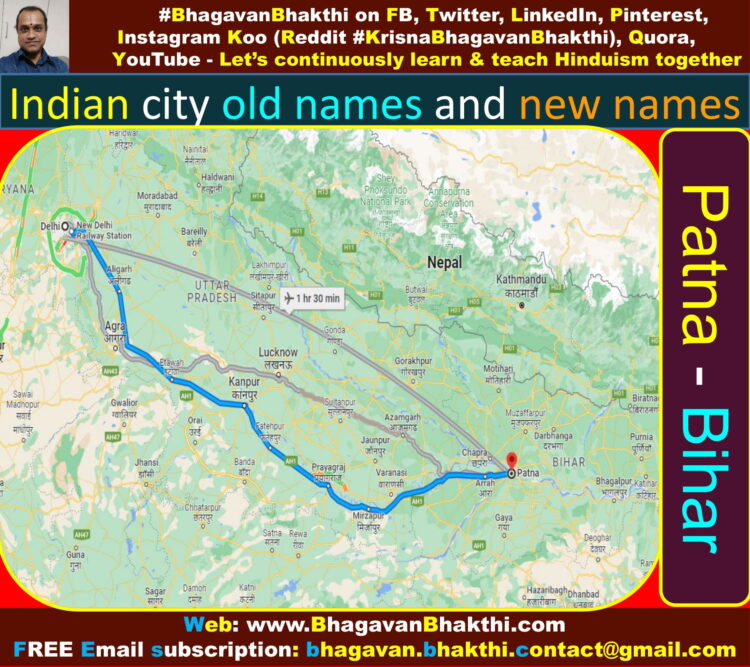
Hampi : This town is also located in Karnataka. Earlier it was called as ‘Pampa‘.
This city is very near to Anegundi (Anegondi) of Karnataka.
The river near the Hemakuta Hill came to be known as Pampa river.
The Sanskrit word Pampa morphed into the Kannada word Hampa and this is the place Goddess Sri Parvati Devi pursued Lord Shiva came to be known as Hampe or Hampi.
The site was an early medieval era pilgrimage place known as ‘Pampa Kshetra‘.

Bankapura : This town is also situated in Karnataka. This place used to be known as ‘Bakasurapura’.
This is the place where the mighty Bhima slayed the demon Bakasura.
During the 9th century, Bankapura was named after Bankeyarasa (in 898 CE) who was a feudatory of Rashtrakoota king Amoghavarsha I.

Hyderabad : This beautiful city earlier was known as the divine name ‘Bhagya Nagara (Nagar)‘.
In Sanskrit and in Telugu, Bhagya means auspiciousness.
The city was also known as Baghnagar (city of gardens), and later acquired the name Hyderabad.
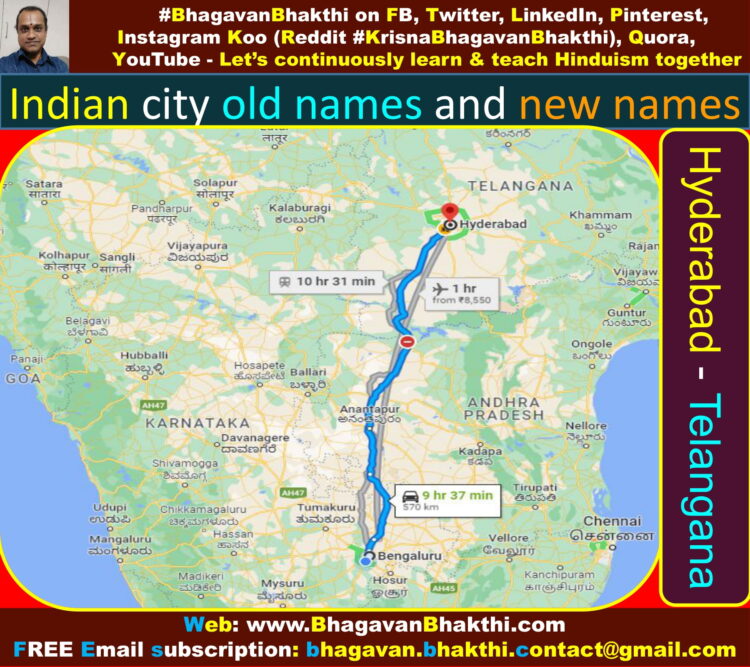
Bengaluru : This green city earlier was known as ‘Bendakaluru‘.
But, Europeans were not able to pronounce this city by the name ‘Bendakaluru’ and they pronounced this city as ‘Bangalore’ and thus it got the same.
Now, it is called as Bengaluru.
In the 9th century, Bengaluru was called ‘Bengaval + Oru‘ (In Kannada it means ‘city of guards’).
In the 12th century, according to another legend, it became ‘Benda + kaalu + Oru‘ (In Kannada it means ‘town of boiled beans’).

Moradabad : The revered town earlier was known as ‘Satyavrata (Satyavrat)‘ in Krita Yuga (Satya Yuga),
‘Mahadgiri‘ during Treta Yuga, ‘Pingala‘ in Dwapara Yuga and ‘Sambhala (Shambal)‘ in Kali Yuga.
In 1624 A.D., Moradabad was captured by Rustam Khan, the then Governor of Sambhal who named it Rustam Nagar.
Later, in 1625 A.D., its named was again changed to Moradabad, after the name of prince Murad Baksh, the son of Mughal emperor Shah Jahan.
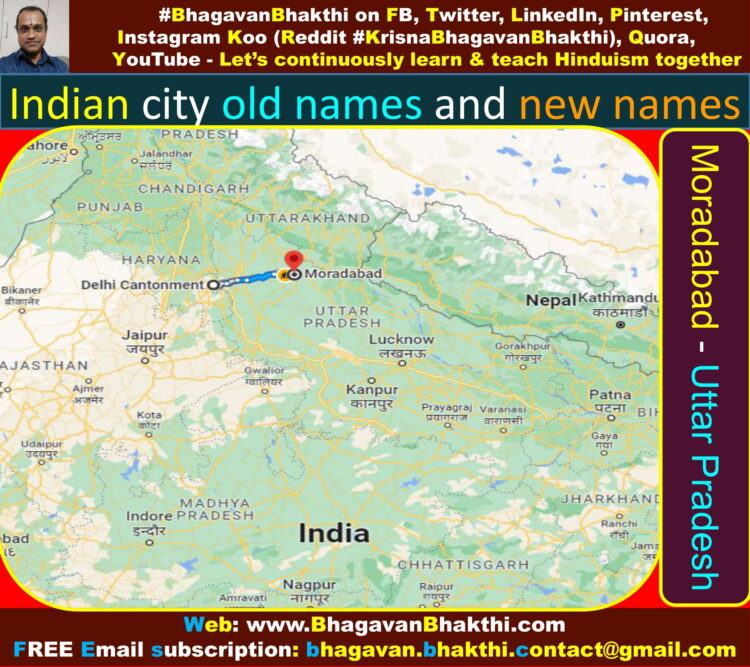
Thiruvananthapuram (Trivandrum) : As Europeans were not able to pronounce the big name Thiruvananthapuram, they pronounced it as Trivandrum.
Earlier, Thiruvananthapuram (Trivandrum) was originally known as ‘Anantapura (Ananthapura)‘, after the Lord Sri Anantha Padmanabhaswamy.
The city Thiruvananthapuram derives its name from Sanskrit and Malayalam word ‘thiru + anantha + puram‘.
This means, ‘The City of Lord Ananta‘, referring to the deity of the Lord Sri Padmanabhaswamy Temple located in the city.
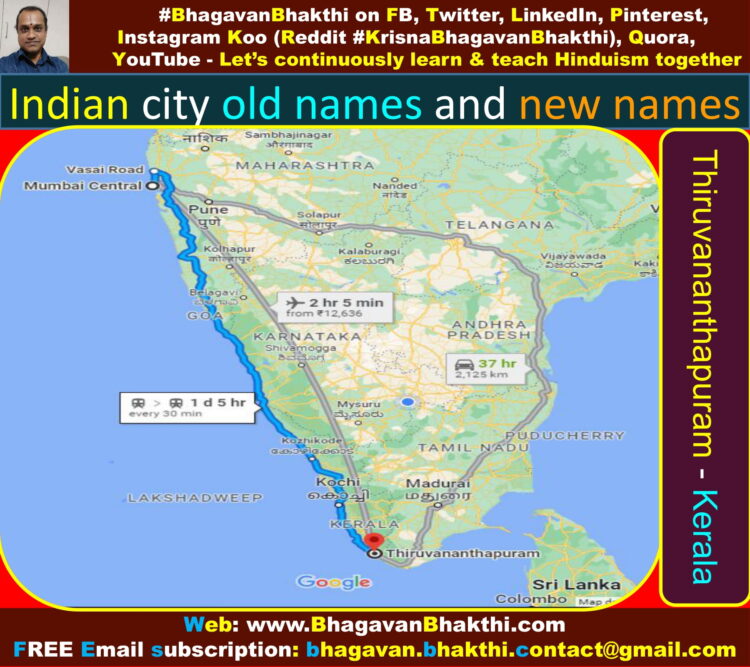
Prayagraj (Allahabad) : This is another holiest city of India and was now as ‘Prayaga (Prayag)‘. Now it is called as ‘Prayagraj‘.
This is the divine place where the Triveni sangam takes place.
That is, the confluence of Ganga, Yamuna and Saraswati rivers takes place in Prayagraj.
The Chinese traveler Huan Tsang in 643 AD found Prayag (Prayagraj) inhabited by many divine Hindus who regarded this place very revered.
In 1575 AD, Akbar founded the city in by the name of ‘Illahabas’.
This name Illahabas later became Allahabad.

Pune (Poona) : This majestic city, earlier was known as ‘Punya Nagara (Nagar)‘.
The earliest reference to Pune (Poona) is an inscription on a Rashtrakuta Dynasty copper plate dated 937 CE.
This refers to the town as ‘Punya-Vishaya‘, meaning ‘auspicious news’.
By the 13th century, it had come to be known as ‘Punawadi‘.
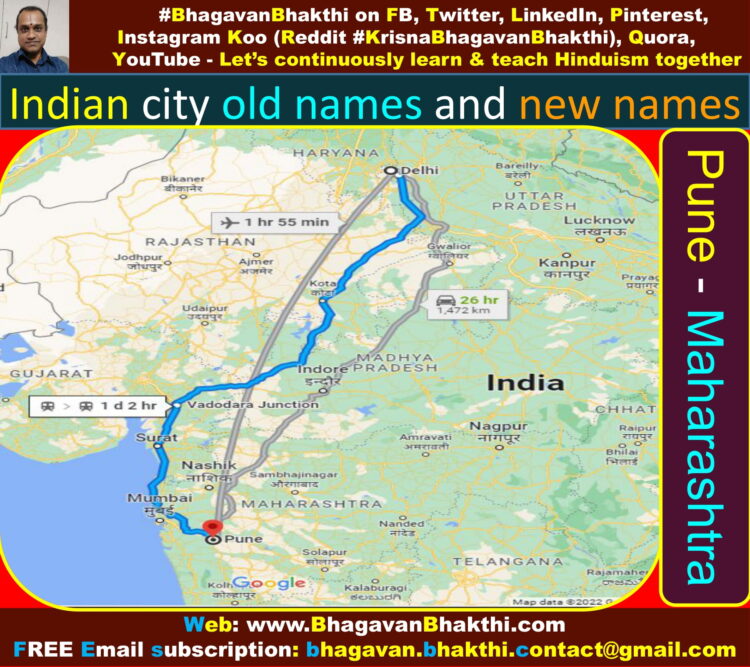
Mysuru : This place was known as ‘Mysore‘, few years back.
But the original name of this great city is called as ‘Mahishasura Pura‘
This city of Mysuru is the place where Goddess Sri Chamundi (Durga Devi) killed the demon Mahishasura.
This is also the place, where the demon Mahishasura was living.

Chennai : This city was known as ‘Madras‘ or ‘Madras Patnam‘ earlier.
The name Chennai is derived from the Telugu language origin.
Chennai name was obtained from the name of a Telugu ruler called as Damarla Mudirasa Chennappa Nayakudu.
He was the father of Damarla Venkatapathy Nayak.
(A Nayak ruler who served as a general under Venkata III of the Vijayanagar Empire from whom the British acquired the town in 1639.)

Mumbai : Because, Europeans were not able to pronounce the city name ‘Mumbai‘, it had become ‘Bombay’.
But now again, this name Mumbai has been reinstated.
The name Mumbai is derived from ‘Mumbā‘ or ‘Mahā-Ambā‘, that is the Goddess Mumba Devi.

Mangaluru : Earlier this city was known as ‘Mangalore’.
This was because, Europeans were not able to pronounce the divine name ‘Mangaluru‘, they started to call it as ‘Mangalore’.
In Kannada, Mangaluru = Mangala + Uru = Auspicious + Place.
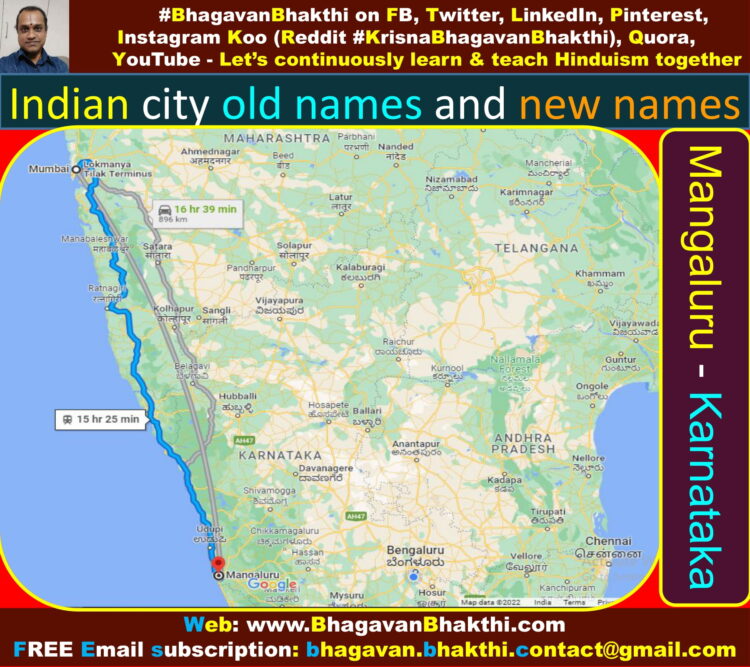
Kannur : The city’s old name is called as ‘Cannanore‘, is an anglicized form of the Malayalam name “Kannur”.
To explain in etymological way, the name Kannur may have been derived from ‘Kanathur‘, an ancient village in Kerala.
Also, there is an another opinion that the explains the place Kannur was originally a portmanteau derived from two Malayalam words ‘Kannan‘ (Lord Krishna), and ‘Oor‘ means a place.
These both words when combined gives a meaning Kannur, that is, ‘The place of Lord Krishna‘.
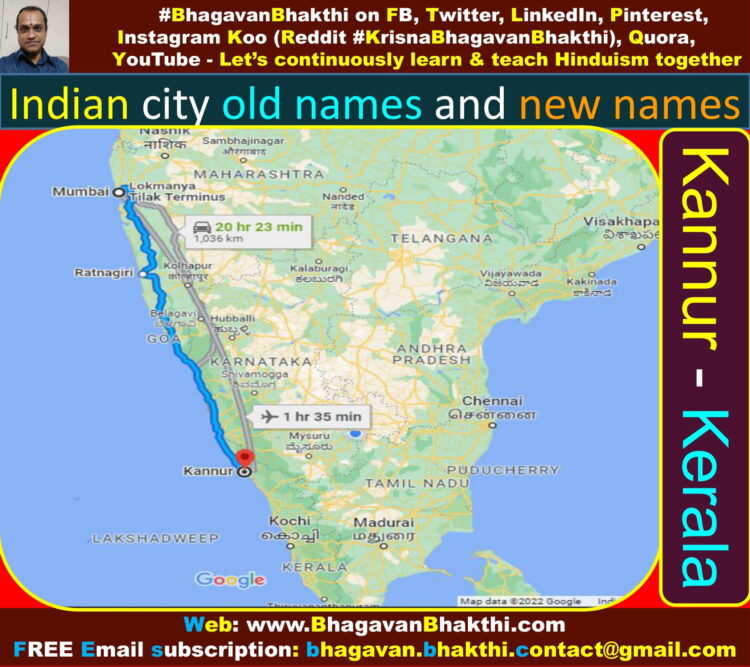
Kolkata : Same problem, Europeans were not able to pronounce this place as ‘Kolkata‘, and thus it had become ‘Calcutta’.
Now, the name Kolkata has be reinstated.
Following English pronunciation, ‘Kāl Kāʈa‘ became “Calcutta”.
The name might have its origin in the words ‘khal‘ meaning ‘canal’, followed by ‘kaṭa‘, which means ‘dug’.
Also, as per another theory, the name Kolkata may have been originated from the Bengali term ‘kilkila‘ (flat area).
One more theory is that the name derives from ‘Kalighat‘.
There is another theory, that is, the area specialized in the production of quicklime or ‘koli chun‘ and coir or ‘kata‘; hence, it was called ‘Kolikata‘, which now is called as Kolkata.

Kollam (Quilon) : One of the oldest name of Kollam (Quilon) was called as ‘Desinganadu‘.
This name Desinganadu was kept after the king Jayasimha from whom the Venad dynasty is supposed to have originated.
One theory says that the name Kollam is derived from the Sanskrit term ‘kollam‘, which means pepper,
This may be because the place had been an ancient trading and exporting centre for pepper.
‘Kollam’ may also have been taken from the word ‘koyillam‘, a telescoping of ‘kovilakam‘ (palace) and ‘illam‘ (brahmin house).
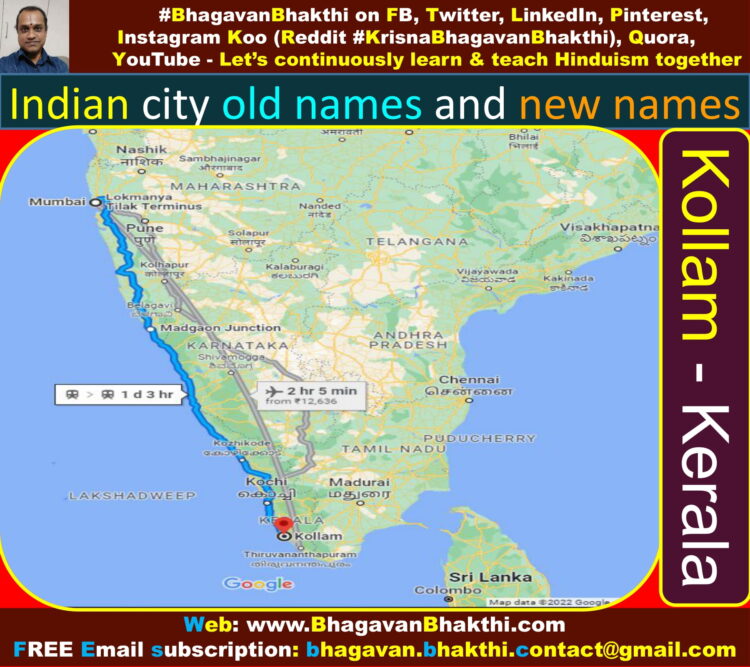
Kanpur (or Cawnpore) : In 1207, the local King, that is, Raja Kanh Deo of the Kanhpuriya lineage of Rajputs.
He established the city of ‘Kanhpur‘ and made it his capital, which later came to be known as Kanpur (or Cawnpore).
As said above, the name Kanpur is a incorrectly pronounced version of its original name ‘Kanhapur‘ (Lord Krishna’s city) given by the two rulers Hindu Singh of Sachendi and Ghanshyam Singh of Ramaipur.
The British officer Hobson Johnson found the divine word Kanhapur difficult to pronounce and he changed it to Cawnpore.
Now, it is known as the name as Kanpur.
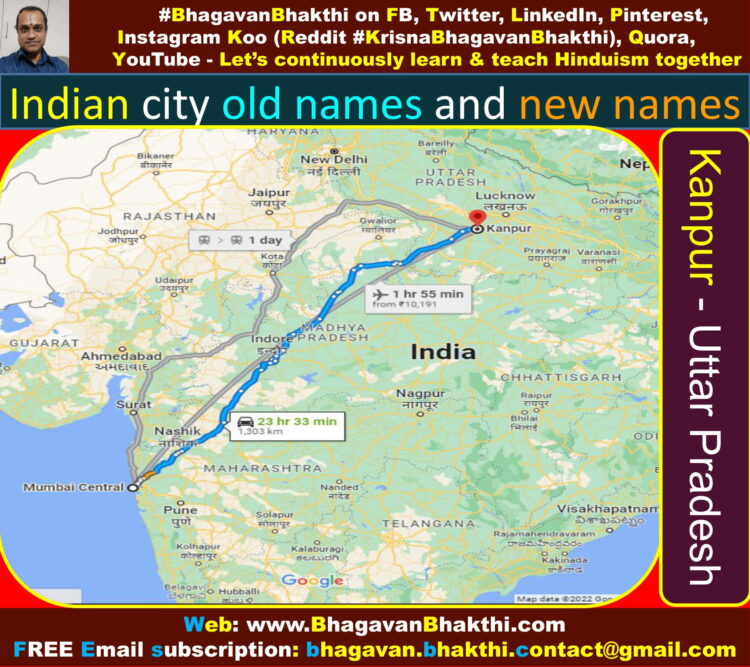
Vadodara : The city Vadodar was once known as ‘Chandravati‘, after the local King Raja Chandan.
Then later it came to be known as ‘Viravati‘, the abode of the brave.
And then it came to be known as ‘Vadpatra‘, because of the abundance of banyan trees on the banks of the Vishwamitri.
From Vadpatra, the present name Vadodara or Baroda name came into existence.

Alappuzha : This Alappuzha district is in Kerala. It was formed as ‘Alleppey‘ district on 17 August 1957.
The name of the place Alleppey, the mispronounced form was changed as ‘Alappuzha’ on 07.02.1990.
It is assumed that the name Alappuzha was derived by the geographical position and physical features of the place which means “the land between the sea and the network of rivers flowing into it”.
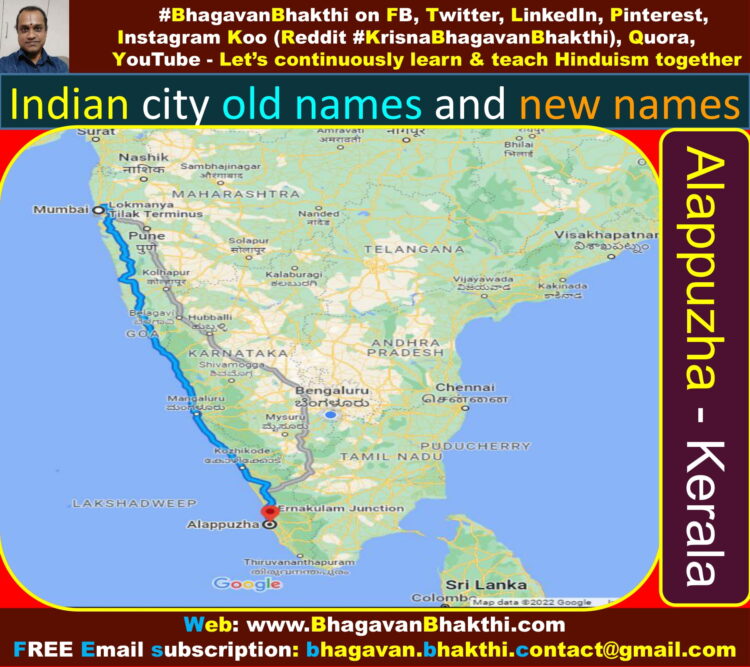
Lucknow : This city name is a mispronounced from the Sanskrit name ‘Lakshmanapuri‘.
According to legend, the Lucknow is named after Lakshmana, the brother of Lord Rama.
The legend states that, Lakshmana had a palace or an estate in the area, which was called Lakshmanapuri.
This name was also called as Lakhanpur or Lachhmanpur in 11th century, and later, Lucknow (Lakhnau).
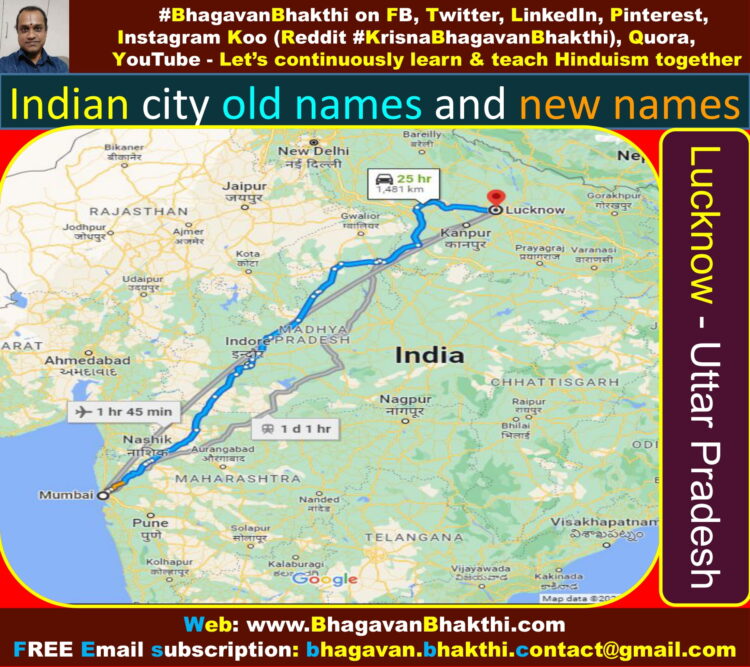
Kochi (Cochin) : This name Kochi is derived from the Malayalam word ‘Kochu azhi‘.
In Malayalam Kochu azhi means ‘small lagoon‘.
Because Europeans were not able to pronounce the word ‘Kochu azhi’, they made short as Cochin.
Now, the city is called as Kochi.
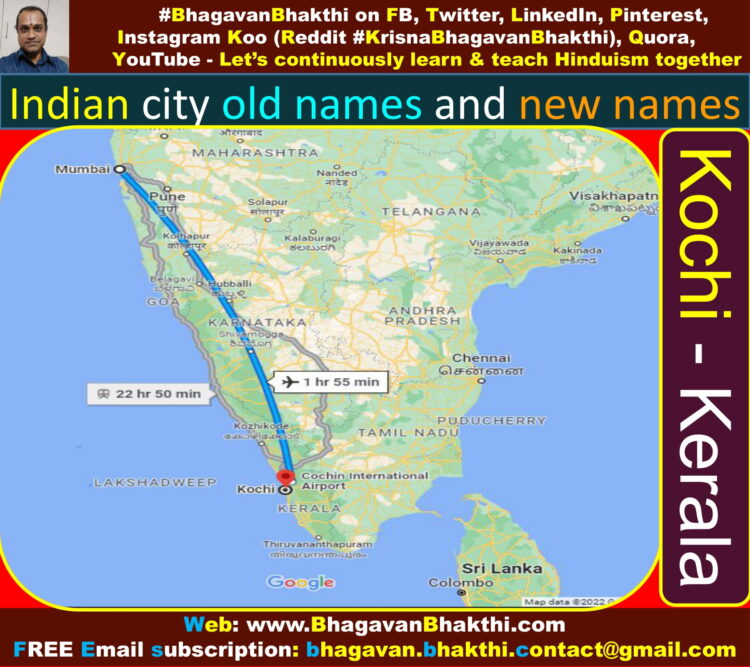
Palakkad (Palghat) : In older days, Palakkad (Palghat) was also known as ‘Palakkattussery‘.
Few people say that Palakkad (Palghat) is derived from an indigenous tree called as ‘Pala‘.
This tree Pala was once densely occupied the local land and hence the name Palakkad (Palghat) came into existence.
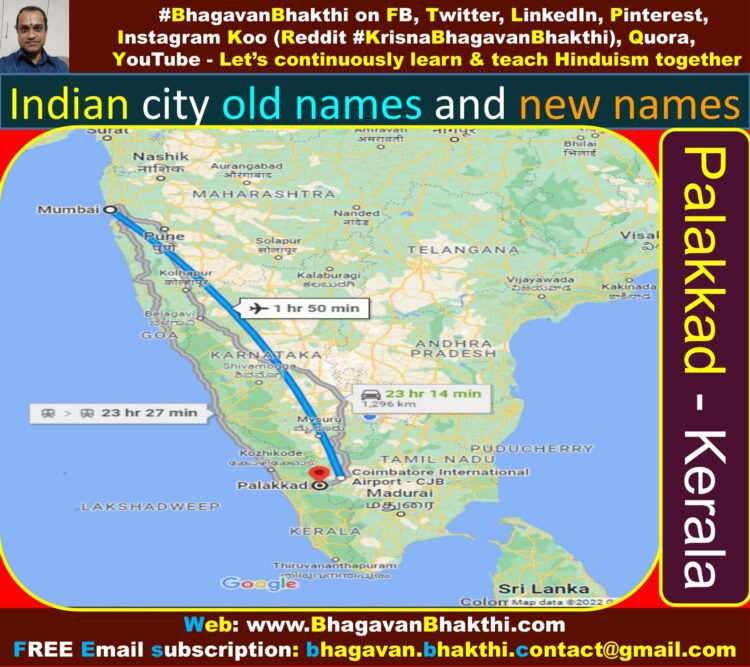
Thrissur (Trichur) : This city name Thrissur was known as Trichur, because of the Europeans bad pronunciation.
In 1990, this name Trichur was changed to Thrissur.
But, originally Thrissur was known as ‘Vrishabhadripuram‘, that is ‘Kailash of the South India‘ in older days.

Thanjavur (Tanjore) : As Europeans were not able to pronounce the word Thanjavur, they pronounued this as Tanjore.
But the original name of Thanjavur (Tanjore) is derived from the name of a Mutharayar King “Dhananjaya” (Also called as Thananjay or Thananjaya).
If Oor (Means a place) is added to Dhananjaya (Thananjaya or Thananjay), it becomes Thanjavur (Tanjore).
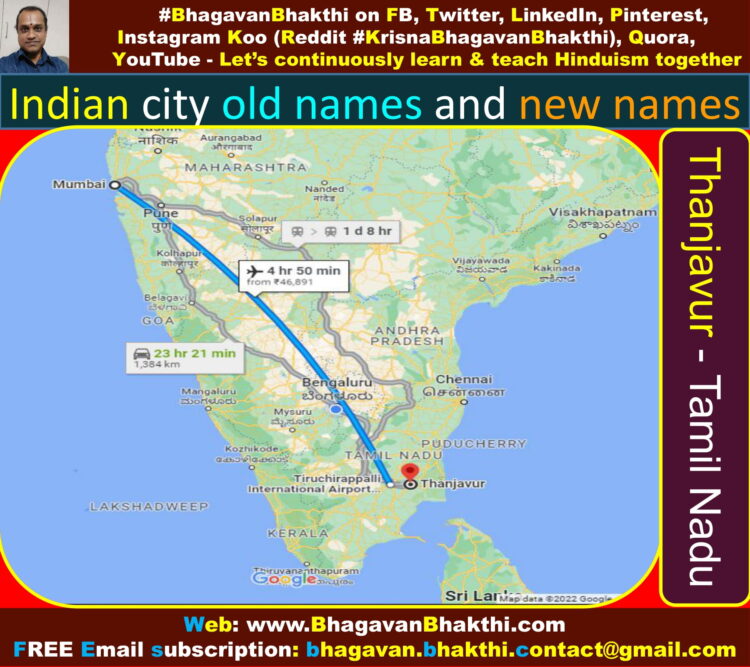
Kannauj : Kannauj is the corrupted word from the original Sanskrit word (name) Kanyakubja.
There is a grand temple of Goddess Sri Gauri Devi (Parvati Devi) in this place. Kanyakubja is named after Goddess Sri Gauri Devi.
This place is located in Kannauj district, in Uttar Pradesh. It was also known as Mahodaya during the time of the King Mihira Bhoja.
More information will be added to this on regular basis. Please visit after some time to get the updated information.
To watch videos on #Hinduism #Sanskrit language, SUBSCRIBE to my YouTube channel from this below link:
#BhagavanBhakthi YouTube channel
To watch YouTube videos about #Sanskrit, subscribe to my YouTube channel from the below link:
To learn about #Sanskrit #Hinduism #SanatanaDharma from this website / blog click the below link:
Learn Sanskrit, Hinduism, Sanatana Dharma from this website / blog
To know more information about Hinduism, please click the below link:
To know more information about Lord Krishna, please click the below link:
To know more information about Lord Rama, please click the below link:
Dear friends, if you need any clarifications about this post, kindly let me know, I will definitely try to answer all of them.
Also your one LIKE, one COMMENT, One Share, one SUBSCRIPTION is highly important.
This will help to know the quality of this content and also it will be helpful to know if any improvements is required for the content.
If you feel this content is useful to you and has helped you to improve your knowledge, kindly share this with your well-wishers.
Because “SHARING MEANS CARING”.
For receive FREE EMAIL SUBSCRIPTION about #BhagavanBhakthi, you can send an email to [email protected] from your email ID.
NAMASTE!
Sri Gurubhyo Namaha
Sri Krishnaaya Namaha
Sri Krishnaarpanamastu
Subscribe / Follow us Share in Social Media
I was very happy to discover this website. I want to to thank you for your time due to this fantastic read!! I definitely liked every little bit of it and i also have you book marked to check out new things on your blog.
excellent submit, very informative. I ponder why the opposite specialists of this sector do not notice this. You must continue your writing. I’m confident, you’ve a huge readers’ base already!